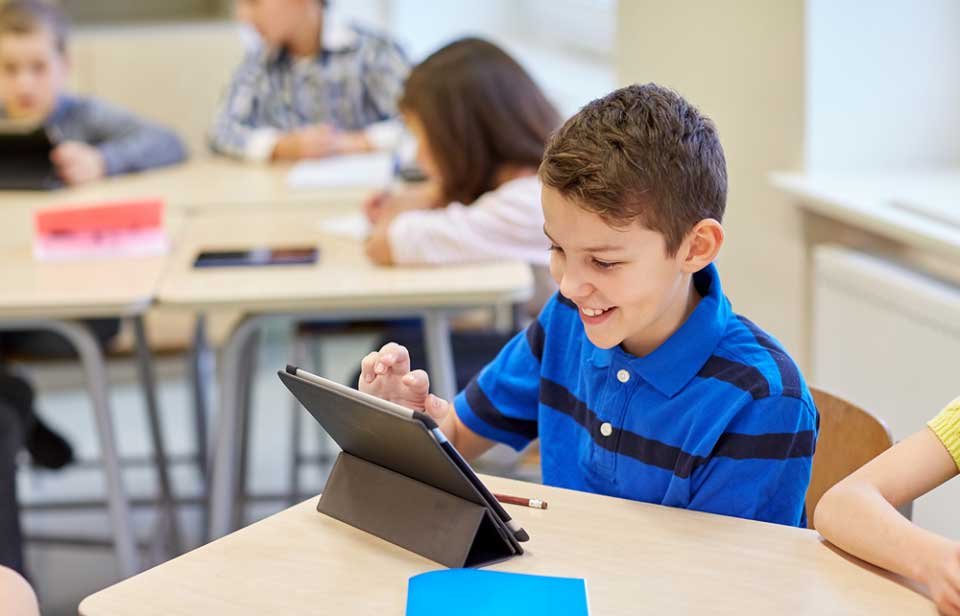Digitalization is changing the way we study and learn. This digital technology is taking over the old school traditional methods of teaching and boredom laden classrooms. The classrooms of 2018 are advanced, including not only the high end and shiny technology but also new and optimized ways of learning and educating students. The educational apps that are developed with Artificial Intelligence and Data Analytics bring personalized and playful learning to life.
The improvement in the technology of educational apps trends is not just improving, it is accelerating! The next-gen Augmented Reality and Virtual Reality apps are booming, predicted to generate massive revenue of $150 Billion by 2020. Today, the students are equipped with digital resources like Smartphone, iPads, Smartboards, etc. Classrooms have evolved into interactive learning workspaces that make use of smart educational apps that are indispensable in the education industry.
The use of digital technologies has clearly set the trend in various useful educational apps. Besides the development of modern hardware, 2018 will also focus on the improvement of digital apps. More and more apps are evolving, getting ready to dominate the market. But where exactly do we stand and what developments can be expected in 2018? Let us take a look at it.
Social Networking for group learning
Social media has established itself as a revolutionary tool, that not only helps in distributing knowledge but at the same time, it arouses the spirit of learning and curiosity among the students. Several social networking platforms such as Facebook, Twitter, WhatsApp, Skype, etc. are available free for use on smartphones and tablets.
Contrary to the belief that social media harms students and their performance, many schools and institutions have proven that it is, in fact, helping in slightly improving the grades. Teachers can broadcast the lessons from any place and discuss school-related topics with different groups. Homework has become fun with the use of social networking, and these trends are surely going to continue in 2018.
Distance Learning apps
The distance learning method is nothing new, but in the recent years, the development in the use of digital technology has definitely changed how students utilize distance learning to their edge. The traditional paper-based study lessons can be distributed over digital media with a click of a button! These paper lessons have taken many different electronic shapes such as PDFs and eBooks. Students can get help with research paper writing apps like TypeMyEssay.
Furthermore, students are supplied with video lessons over the internet which is a very useful resource for learning. Students who are unable to afford on-campus lectures, need not worry a bit, as distance learning over educational apps like Udacity and Schoology is being offered at most of the institutions around the United States.
Cloud Computing
Over 90% of the students who belong to the age group 12-19 own a Smartphone. Since most of the students have the ability to connect digitally, schools and colleges are offering cloud-based eLearning programs. Cloud computing benefits an institution by decreasing their IT infrastructure costs. It provides content resources for learning both offline in classrooms as well as in online courses.
Cloud computing solves the issue of storage and accessibility. Comparing it with the old-school lockers, students can access and search their lessons, homework or assignments anytime from any device. Google Drive provides simple yet fast and robust cloud computing environment for students.
Game-based Learning
Since the mid-90s, Internet-based games are being used in teaching and learning. Although the concept is not new, it has surely gained traction in the market in 2018. Game-based Learning aims to increase the motivation of the students and to support learning processes through an interactive application. These educational apps like Axiom, Answerables, Fun Brain, Little Digits, etc. provide ‘Gamification’ in the form of interactive puzzles, simulations, and quizzes.
Social networking games and browser games allow greater focus on the subject and active involvement of the group. Game-inspired simulations can help in shaping an optimized educational structure that is easy to grasp and fun to learn.
Virtual Reality is the future of EdTech
VR is a diverse form of digitally generated artificial worlds that provide versatile multimedia simulation environments. Students are not only provided hand-to-hand experience with data but the ability to interact with the data as well. With the help of a head-mount display, a virtual reality environment can be created, that can offer students the opportunity to observe 360-degree video training.
Without any doubt, Virtual Reality is the future of social teaching and learning. In the recent years, the innovation in this field of technology has been exploding with the introduction of various VR devices like Oculus Rift. VR classroom educational apps like zSpace, In Mind 2 and Anatomy create engagement through virtual exploration.
Artificial intelligence & Machine Learning
Despite modern developments in Artificial Intelligence, we may be far behind in utilizing the true power of AI. But needless saying, technological advancements in AI and Machine Learning for the purpose of eLearning are reaping fruits. Several autonomous AI learning guides and chatbots are introduced to the schools. For example, ‘Mika’ is a personalized virtual tutor that can adapt to the particular behavior of the students and provide necessary feedback. Rallyware is another AI-powered app that can provide personalized enterprise training in a firm.
Blended Learning
Blended Learning makes use of a Learning Management System (LMS) that creates a flexible learning environment inside a classroom. With the advancement in technology in classrooms, Blended Learning has developed as a key tool in eLearning. Students can refer to online-based instructional tools and are provided with customized lessons to work with peer groups.
Interactive educational apps like EDpuzzle and Nearpod can help students to watch video lessons outside the school hours, leaving enough time in the classroom to engage in discussion.


